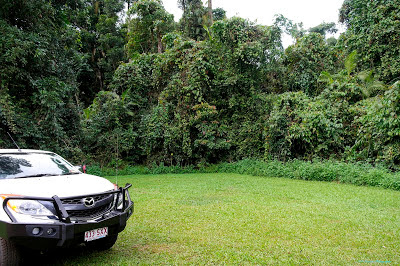After 'The Maroons' lost Origin 1 we had to leave The Beachcomber at Cardwell as it was a'Blues' nest. We were out numbered about 6 to 1. We edged a little further north to the Tully Area. Other travellers had told us of the camp at Hull Heads so we decided to look there first. Only one other camp set up when we arrived, we found a great spot with an outlook over The Hull River and could follow all 'the goings on' in the camp. Terry and June, people we had met on another trip, live at Tully, we contacted them and they drove out to Hull Heads for a chat along with their Chihuahua, Dolly. We stayed at Hull Heads for three days until rain made the decision to move on an easy one. Our visit to The Wet Tropics is living up to it's name, seems to be raining every day since we arrived around Tully. Other travellers are saying we have arrived too early, the better weather will be next month. I don't know whether they are having us 'ON' or not.

Tully is known for it's high rainfall, therefore they have the BIG GUMBOOT. The low mist on the range behind Tully is very evident, but at least it wasn't raining at this moment.
Some of the Tully township as viewed from the top of The Gumboot.
Also viewed from the top of The Gumboot is The Tully Sugar Mill, which is right in the town area.
If you can enlarge this photo you will be able to read all the statistics of Tully.
While we were camped at Hull Heads we rode our bikes the 5.5 km to Tully Heads. This is Carron Esplanade on the way into town. We were facing a SE breeze on the way in but the return trip was easy.
Looking northwards along the beach with The Tully River at my back.
As you will remember this area of Queensland bore the brunt of Cyclone Yasi, February 2011. Many homes are still vacant and unrepaired. The upper level from the front of this house has disappeared. Many homes have been completely destroyed with only the plumbing remaining on the property.
Another deserted home, it is really depressing to see the damage inflicted on these communities. Many families have moved away for good. The Caravan Park that was here has closed down as well.
On our way out of Tully Heads now, on Carron Esplanade from the south end.
This is The Coast Guard Station at Hull Heads, the camp area is behind the building and extends along The Hull River.
The Hull River at near high tide looking towards the river outlet. Colin is trying his luck at a bit of fishing. No one was very successful at this time.
Looking upstream along The Hull River towards the Boat Ramp. The ramp is fairly difficult to see as the tree line obscures plain view.
On the beach at the river outlet looking back towards the homes of the Hull Heads Community. Many of the homes here have been restored to liveable status but some have been demolished and vacant blocks is all that remains.
























































